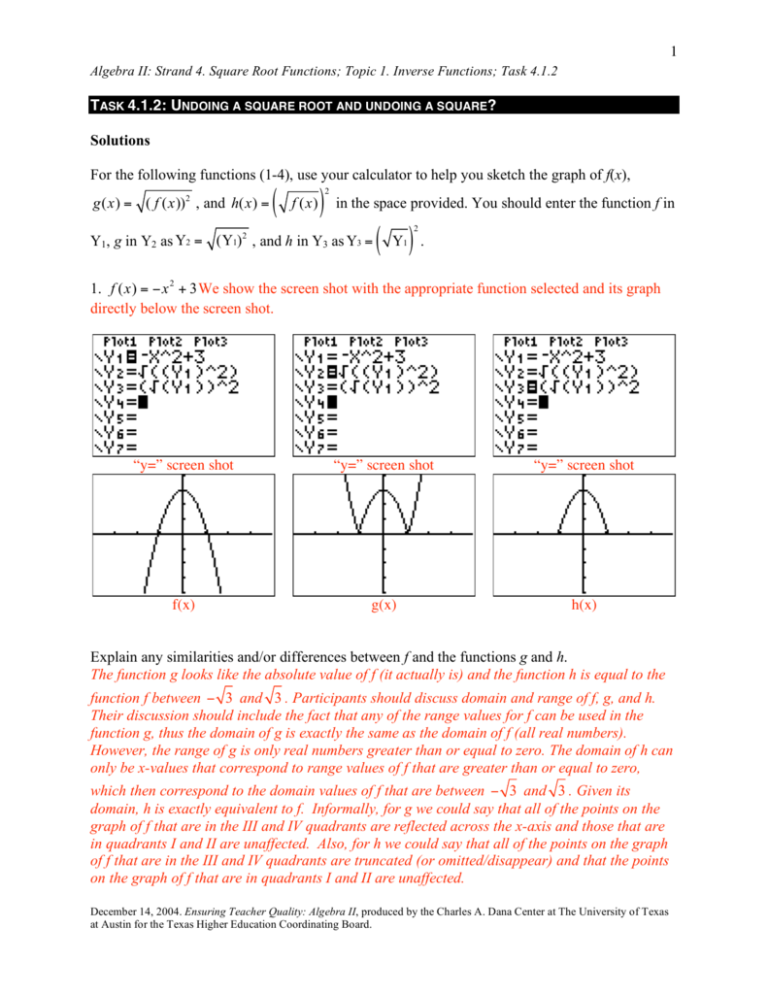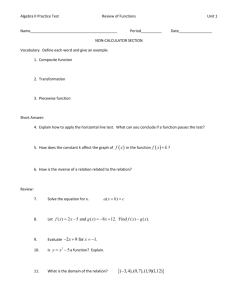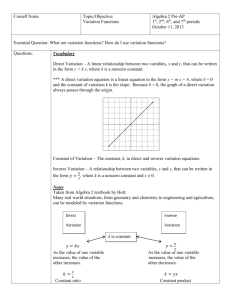1 Solutions For the following functions (1
advertisement

1 Algebra II: Strand 4. Square Root Functions; Topic 1. Inverse Functions; Task 4.1.2 TASK 4.1.2: UNDOING A SQUARE ROOT AND UNDOING A SQUARE? Solutions For the following functions (1-4), use your calculator to help you sketch the graph of f(x), g(x) = ( f (x))2 , and h(x) = ( f (x) ) 2 in the space provided. You should enter the function f in Y1, g in Y2 as Y2 = (Y1)2 , and h in Y3 as Y3 = 2 ( Y). 1 1. f (x) = !x 2 + 3 We show the screen shot with the appropriate function selected and its graph directly below the screen shot. “y=” screen shot “y=” screen shot “y=” screen shot f(x) g(x) h(x) Explain any similarities and/or differences between f and the functions g and h. The function g looks like the absolute value of f (it actually is) and the function h is equal to the function f between ! 3 and 3 . Participants should discuss domain and range of f, g, and h. Their discussion should include the fact that any of the range values for f can be used in the function g, thus the domain of g is exactly the same as the domain of f (all real numbers). However, the range of g is only real numbers greater than or equal to zero. The domain of h can only be x-values that correspond to range values of f that are greater than or equal to zero, which then correspond to the domain values of f that are between ! 3 and 3 . Given its domain, h is exactly equivalent to f. Informally, for g we could say that all of the points on the graph of f that are in the III and IV quadrants are reflected across the x-axis and those that are in quadrants I and II are unaffected. Also, for h we could say that all of the points on the graph of f that are in the III and IV quadrants are truncated (or omitted/disappear) and that the points on the graph of f that are in quadrants I and II are unaffected. December 14, 2004. Ensuring Teacher Quality: Algebra II, produced by the Charles A. Dana Center at The University of Texas at Austin for the Texas Higher Education Coordinating Board. 2 Algebra II: Strand 4. Square Root Functions; Topic 1. Inverse Functions; Task 4.1.2 2. f (x) = x 2 ! 3 “y=” screen shot f(x) g(x) h(x) Explain any similarities and/or differences between f and the functions g and h. The function g looks like the absolute value of f (it actually is) and the function h is equal to the function f for x ! " 3 and x ! 3 . Participants should discuss domain and range of f, g, and h. Their discussion should include the fact that any of the range values for f can be used in the function g, thus the domain of g is exactly the same as the domain of f (all real numbers). However, the range of g is only real numbers greater than or equal to zero. The domain of h can only be x-values that correspond to range values of f that are greater than or equal to zero, which then correspond to the domain values of f that are less than ! 3 and greater than 3 . Given its domain, h is exactly equivalent to f. Informally, for g we could say that all of the points on the graph of f that are in the III and IV quadrants are reflected across the x-axis and those that are in quadrants I and II are unaffected. Also, for h we could say that all of the points on the graph of f that are in the III and IV quadrants are truncated (or omitted/disappear) and that the points on the graph of f that are in quadrants I and II are unaffected. December 14, 2004. Ensuring Teacher Quality: Algebra II, produced by the Charles A. Dana Center at The University of Texas at Austin for the Texas Higher Education Coordinating Board. 3 Algebra II: Strand 4. Square Root Functions; Topic 1. Inverse Functions; Task 4.1.2 3. f (x) = x 2 + x + 1 f(x)=g(x)=h(x) “y=” screen shot Explain any similarities and/or differences between f and the functions g and h. Since the function f is always positive, the functions g and h are indistinguishable from (equal to) f. Participants should discuss domain and range of f, g, and h. This can be seen from the informal discussions of the previous two exercises. That is, since there are points on the graph of f in quadrants III and IV, the graphs of g and h will look exactly the same as the graph of f. 4. f (x) = !2x 2 ! 3x ! 2 “y=” screen shot f(x) h(x) Table for h(x) g(x) Explain any similarities and/or differences between f and the functions g and h. The function g looks like the absolute value of f (it actually is) and the function h is undefined. Participants should discuss domain and range of f, g, and h. Their discussion should include the fact that any of the range values for f can be used in the function g, thus the domain of g is exactly the same as the domain of f (all real numbers). However, the range of g must be positive. December 14, 2004. Ensuring Teacher Quality: Algebra II, produced by the Charles A. Dana Center at The University of Texas at Austin for the Texas Higher Education Coordinating Board. 4 Algebra II: Strand 4. Square Root Functions; Topic 1. Inverse Functions; Task 4.1.2 The domain of h can only be x-values that correspond to range values of f that are greater than or equal to zero. Since there are no range values of f that are greater than or equal to zero, h is undefined for all x. Informally, for g we could say that all of the points on the graph of f are in quadrants III and IV—thus, all points are reflected across the x-axis. Also, for h we could say that since all of the points on the graph of f are in the III and IV quadrants the all disappear. 5. Based upon your findings, what affect does ( f (x) ) 2 ( f (x))2 have on a function f? What affect does have on a function f? Justify your answers—include an explanation of the effect of the domain and range of f on the outcomes as well as doing and undoing effects of the composition of inverse functions (Recall: Task 1.4.1). Recall from Task 1.4.1 that domain of a function and the range of its inverse function must be equivalent and that the range of a function and the domain of its inverse function must also be equivalent. For exercises 1-4, we can think of the function g as a composition of three ( ( ( ))) . Note that r (s ( x )) = x functions: s(x) = x 2 , r(x) = x , and f (x) . That is, g(x) = r s f x only for the range values of s that are equivalent to the domain values of r. The function r is the ( ( ( ))) and note inverse function for s only for x ! 0 . Similarly, we can think of h as h(x) = s r f x ( ( )) that s r x = x only for range values of r that are equivalent to domain values of s. The function s is the inverse function for r only for x ! 0 . Thus, even though the composition of r and s are “doing” and “undoing” an operation, we only retrieve the original function or value on the appropriate correspondence of the domain and range of the composed functions. ( f (x))2 is equivalent to composing the absolute value function with the function f. That is, we get f (x) when f (x) ! 0 and ! f (x) when f (x) < 0 . ( ) 2 f (x) is equivalent to taking only the values of f that are greater than or equal to zero. That is, we get f (x) when f (x) ! 0 and ( f (x) ) 2 is undefined when f (x) < 0 . Math notes This task emphasizes the necessity of the correspondence of the domain and range of inverse functions. That is, the inverse function only “undoes” the effect of the function on the appropriate corresponding domain and range values. Teaching notes When implementing this task, have participants input the functions f, g, and h as shown in the solutions above. If the participants attempt to simplify the functions algebraically first, they may incorrectly conclude that f, g, and h are all equivalent by incorrectly assuming squaring a function and then taking the square root (or vice versa) gives back the original function. December 14, 2004. Ensuring Teacher Quality: Algebra II, produced by the Charles A. Dana Center at The University of Texas at Austin for the Texas Higher Education Coordinating Board. 5 Algebra II: Strand 4. Square Root Functions; Topic 1. Inverse Functions; Task 4.1.2 TASK 4.1.2: UNDOING A SQUARE ROOT AND UNDOING A SQUARE? For the following functions (1-4), use your calculator to help you sketch the graph of f(x), g(x) = ( f (x))2 , and h(x) = ( f (x) ) 2 in the space provided. You should enter the function f in Y1, g in Y2 as Y2 = (Y1)2 , and h in Y3 as Y3 = 1. ( ) 2 Y1 . f (x) = !x 2 + 3 Explain any similarities and/or differences between f and the functions g and h. December 14, 2004. Ensuring Teacher Quality: Algebra II, produced by the Charles A. Dana Center at The University of Texas at Austin for the Texas Higher Education Coordinating Board. 6 Algebra II: Strand 4. Square Root Functions; Topic 1. Inverse Functions; Task 4.1.2 2. f (x) = x 2 ! 3 Explain any similarities and/or differences between f and the functions g and h. December 14, 2004. Ensuring Teacher Quality: Algebra II, produced by the Charles A. Dana Center at The University of Texas at Austin for the Texas Higher Education Coordinating Board. 7 Algebra II: Strand 4. Square Root Functions; Topic 1. Inverse Functions; Task 4.1.2 3. f (x) = x 2 + x + 1 Explain any similarities and/or differences between f and the functions g and h. December 14, 2004. Ensuring Teacher Quality: Algebra II, produced by the Charles A. Dana Center at The University of Texas at Austin for the Texas Higher Education Coordinating Board. 8 Algebra II: Strand 4. Square Root Functions; Topic 1. Inverse Functions; Task 4.1.2 4. f (x) = !2x 2 ! 3x ! 2 Explain any similarities and/or differences between f and the functions g and h. December 14, 2004. Ensuring Teacher Quality: Algebra II, produced by the Charles A. Dana Center at The University of Texas at Austin for the Texas Higher Education Coordinating Board. 9 Algebra II: Strand 4. Square Root Functions; Topic 1. Inverse Functions; Task 4.1.2 5. Based upon your findings, what effect does ( 2 ( f ( x)) have on a function f? What affect does 2 f ( x) ) have on a function f? Justify your answers—include an explanation of the effect of the domain and range of f on the outcomes as well as doing and undoing effects of the composition of inverse functions (Recall: Task 1.4.1). December 14, 2004. Ensuring Teacher Quality: Algebra II, produced by the Charles A. Dana Center at The University of Texas at Austin for the Texas Higher Education Coordinating Board.







